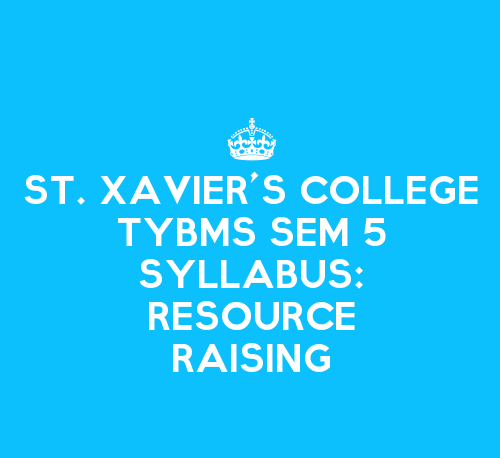Resource Raising is an elective subject in TYBMS Sem 5 at St. Xavier’s College. The subject gives brief introduction of what are different sources of finance, understand how to use these sources to raise finance in business and helps BMS students understand how to do valuation of sources of finance.
Unit 1 – 15 lectures
Capital markets:
- Define financial system and describe its 3 main components
- Financial assets / instruments
- Financial intermediaries / institutions and the 2 key financial markets, namely, capital and money markets
Equity / Ordinary Shares:
- Discuss the general features of equity / ordinary shares, the important aspects of preemptive rights of shareholders and the merits and demerits of ordinary share financing.
- IPO, ESOP, Bonus share, right issue, sweat equity.
Term Loans, Debentures / Bonds and Preference shares
- Characteristics of term-loans,
- Positive and negative covenants in a loan agreement,
- Loan amortization and the procedure associated with a term-loan
- Describe the basic characteristics of corporate debentures / bonds / notes,
- General features of a debenture issue,
- Bond refunding options,
- Innovative debt instrument,
- The procedure of issuing debt instruments and rating of debt instruments.
Unit 2 – 16 lectures
Leasing and Hire Purchase
- Define leasing, describe its main features and classification of leasing – finance lease, operating lease, sale and lease back, single investor and leveraged lease, domestic and international lease – and the significance and limitations of leasing.
- Review and illustrate financial evaluation of leasing both from lessee’s perspective and lessor’s perspective
- Describe the general features of hire-purchase, comparison of hire-purchase with leasing and installment payment, and financial evaluation of hire-purchase transaction from the viewpoint of the hirer as well the finance company.
Unit 3 – 14 lectures
Venture Capital Financing:
- Discuss the basic features of venture capital: selection of investments, stages of financing, financial analysis, structuring the deal / financing instruments, investment monitoring / nurturing in terms of style, objectives of after care and techniques, portfolio valuation, structure and legal framework, and exist of investments.
- Review of Indian venture capital scenario in terms of the SEBI regulations.
Unit 4 – 15 lectures
Dividend and Valuation:
- Describe the Modiilani – Miller (MM)approach to the irrelevance of dividends and evaluate its validity
- Explain and illustrate the 2 models – Walter’s and Gordon’s – according to which dividends are relevant and affect the value of the firm.
Determinants of Dividend Policy:
- Describe the general factors that affect dividend policy
- Review and evaluate the 3 basic types of dividend policies – constant dividend per share, constant payout ratio and stable dividend plus extra dividend.
- Contrast the basic features of bonus shares and share splits
- Understand the legal, procedural and tax aspects of dividend policy.
Continuous Internal Assessment:
- Mid Semester Test
- Project work- Assignment
The list of reference books for the subject is as follows:
- Financial Management – Chandra Prasana, Tata McGraw
- Financial Management – Khan, M and Jain, P Tata McGraw
- Financial Management and Policy – Jams, C Prentice Hall of India
- Financial Management – Pandey, I.M. Tata McGraw




0 Comments